| Objective | To demonstrate the importance of oxygen in the corrosion of Iron in 3.5% NaCl solution. |
| Materials | One cylinder of Oxygen and Nitrogen each, with pressure gauges and control valves |
| Two 500 ml, Pyrex conical flasks | |
| Two 10 inch length of 6-8 mm, glass tubing | |
| Suitable lengths of rubber tubing | |
| 3.5% Na Cl solution | |
| Two steel wool | |
|
|
|
| Procedure |
Pour 250 ml of 3.5% NaCl solution in to each of the 500 ml conical
flasks. Use gleass tube as bubblers. Connect one to the source of
nitrogen and allow it to bubble through 3.5% NaCl solution in one of
the flasks. Similarly allow oxygen to bubble through 3.5% NaCl
solution in the second flask. Introduce the steel wool in to both the
flasks containing 3.5% NaCl solution. |
|
|
|
| Continue bubbling the gasses through their respective flasks and observe the developments of rust during a period of several hours. | |
|
After a couple of hours,
|
|
| Conclusion |
Iron does not corrode in water saturated with nitrogen. Oxygen is a corrodant as shown by the change of color of water to brown because of corrosion of iron. Passing nitrogen in the system to blanket oxygen is called “Deaeration”. |


